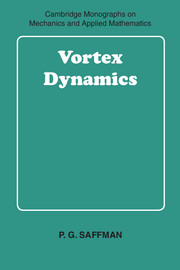Book contents
- Frontmatter
- Contents
- Preface
- 1 Fundamental properties of vorticity
- 2 Singular distributions of vorticity
- 3 Vortex momentum
- 4 Motion with surfaces
- 5 Some applications
- 6 Creation of vorticity
- 7 Dynamics of line vortices in two-dimensional flow
- 8 Vortex sheets in two dimensions
- 9 Dynamics of two-dimensional vortex patches
- 10 Axisymmetric vortex rings
- 11 Dynamics of vortex filaments
- 12 Three-dimensional vortex instability
- 13 Effects of viscosity
- 14 Miscellaneous topics
- Epilogue
- References
- Index
6 - Creation of vorticity
Published online by Cambridge University Press: 05 August 2012
- Frontmatter
- Contents
- Preface
- 1 Fundamental properties of vorticity
- 2 Singular distributions of vorticity
- 3 Vortex momentum
- 4 Motion with surfaces
- 5 Some applications
- 6 Creation of vorticity
- 7 Dynamics of line vortices in two-dimensional flow
- 8 Vortex sheets in two dimensions
- 9 Dynamics of two-dimensional vortex patches
- 10 Axisymmetric vortex rings
- 11 Dynamics of vortex filaments
- 12 Three-dimensional vortex instability
- 13 Effects of viscosity
- 14 Miscellaneous topics
- Epilogue
- References
- Index
Summary
Formation of a vortex sheet
In perfect barotropic fluid, acted upon by conservative forces with a single-valued potential, the first Helmholtz law (§1.5) says that it is not possible to endow a fluid particle with vorticity, and Kelvin's circulation theorem (§1.6) shows that the circulation around a material circuit is zero if initially zero. The question arises whether vorticity can be created without violating these theorems, and without invoking viscosity, non-conservative forces or baroclinic effects. There is no a priori reason why they are not important in subsequent motion if present initially, and so one wishes to know if vorticity can be created without appeal to these effects.
Klein [1910] addressed this question with his Kaffeelöffel experiment. (See also Betz [1950].) The conclusion is that the Helmholtz and Kelvin theorems preclude the generation of piece-wise continuous vorticity, but do not prevent the formation of vortex sheets or the generation of circulation. Consider Klein's experiment. A two-dimensional plate of width 2a is set in motion through a perfect incompressible fluid with velocity U normal to the plate. We introduce the complex potential w(z) = φ+iψ, z = x+iy. The boundary conditions are ψ = Uy on x = 0, |y| < a (the axes are taken to coincide instantaneously with the plate with the y-axis along the plate and the x-axis in the direction of motion), and w ∼ 0 as z → ∞ (circulation at infinity is not allowed).
- Type
- Chapter
- Information
- Vortex Dynamics , pp. 95 - 115Publisher: Cambridge University PressPrint publication year: 1993



